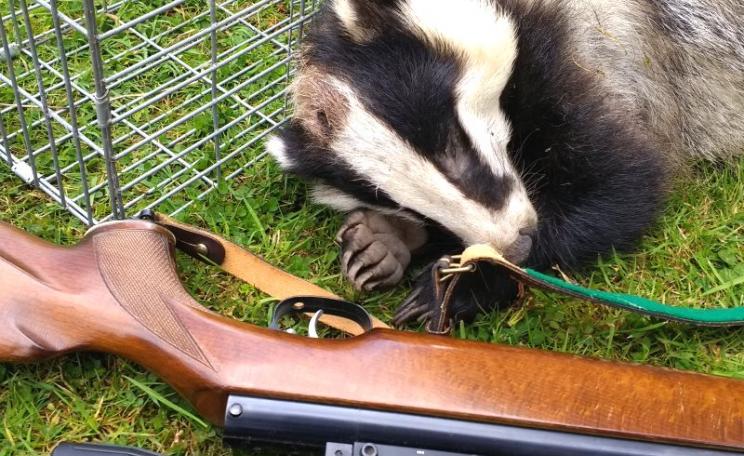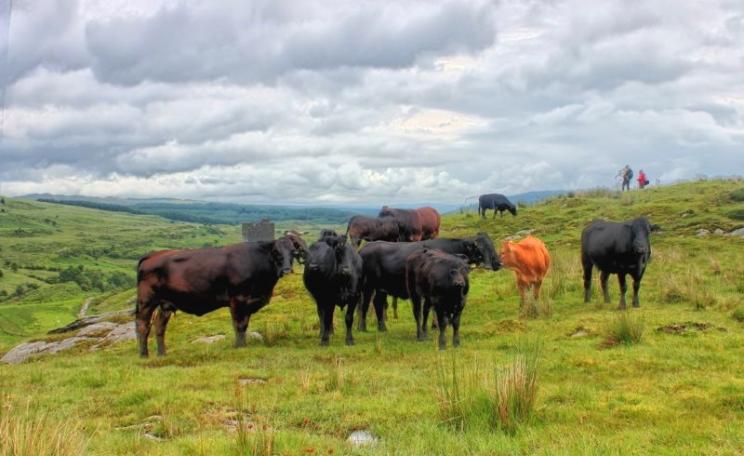If you get such an infection it means it cannot be treated by tablets - you have to go into hospital for antibiotics of last resort, and now resistance is developing to these too.
The black and white photograph on the right is me aged three, with part of my father's small herd of pedigree Wessex Saddleback pigs.
The year is 1953, and the following year moves introduced at the urging of the pro-intensive National Farmers Union, made it uneconomical for any British farmer to keep traditional free-range pigs like these.
As a result, my father, in common with almost all other free-range pig producers in the country (numbering tens of thousands at that time) was forced to have these sows slaughtered and to go out of pig production. It was a major blow to him on his first small (39 acre) farm, and to us as a family.
Behind the move was the fact that British farmers were being encouraged to move their animals out of the fields and onto concrete, with a bribe to plough up their grassland - land which was then used to grow grain to feed the animals that had been moved indoors.
Antobiotics saved my life
To make it possible to keep pigs and chickens in this unnatural way, and to make them grow as fast as possible, MPs had voted in 1953 (just ten years after penicillin first became available to save lives) to allow antibiotics to be added to livestock feed every day from birth to slaughter.
Iain McCleod, the Minister of Health, told them in Parliament that he had been assured by the Medical Research Council that this would have "no adverse effect whatever upon human beings."
Six months after the photograph was taken I scratched my hand on some barbed wire and this caused an infection, which turned into blood poisoning.
I didn't actually feel ill, but a red line developed up my arm. I was rushed into hospital and injected with antibiotics for five days. I remember the injections even now! But they saved my life.
When my parents went to school in the 1930s, there were no antibiotics. There were children in their classes who had lost siblings to infectious diseases. My grandmother's first husband died from an infection, and my mother's best friend at primary school died from one when she was eight.
So once they realised how seriously my life was in danger, they became extremely concerned.
Our return to the 'pre-antibiotic era'
My father came to collect me from the hospital when I was better, but before we went home he took me into the toy shop in our local village, Bourton-on-the-Water, and told me I could choose any toy I liked.
Even at that age I knew we weren't well off, and I remember deliberately not going for the most expensive toy I'd have liked. I chose a Dinky Toy car transporter, which I still have, to go with a Dinky Toy car I already had.
It looks dreadfully old fashioned today, but just as adding antibiotics to pig feed seemed like state of the art to intensive pig farmers at that time, so this toy seemed very modern to me.
It cost ten shillings - 50p in today's money, but that was 20% of my father's average weekly income at that time and probably more than my mother spent at the grocers on a Friday.
If you get such an infection it means it cannot be treated by tablets - you have to go into hospital for antibiotics of last resort, and now resistance is developing to these too.
I didn't learn until many years later that my father quietly gave up smoking for a month to make up for this un-budgeted purchase - something he was never able to do later, even when it might have prevented his own early death.
The reason for giving this personal example, of course, is to illustrate, as best I can from my own experience, what is meant by "a return to the pre-antibiotic era".
Now ordinary infections can kill once again
I am a founding member of a new global coalition of concerned civil society organisations from six continents, and this, we are warning, is a situation we are very close to entering.
Antibiotic resistance is currently increasing at an alarming rate, greatly exacerbated by the fact that there are currently no new antibiotics on the horizon for serious infections, including E. coli blood poisoning, multi-drug resistant gonorrhoea, and extensively drug-resistant tuberculosis.
E. coli are an enormous family of bacteria that double in numbers every 20 minutes. Most of them are not just harmless, but essential for our wellbeing. But amongst them are various types, like the infamous O157, which periodically causes fatal cases of food poisoning.
Another very different but significant group of E. coli bacteria live in our intestines and the intestines of animals harmlessly, but can cause urinary tract infections and blood poisoning when they get out.
There are now over 40,000 cases of blood poisoning and about one million urinary tract infections caused every year in the UK by E. coli.
A new form of antibiotic resistance thrives in British farm animals
A decade ago a new type of resistance known as ESBL (extended spectrum beta lactamase) was first found in E. coli from British farm animals. Before that it had been found only rarely in humans. Now one in every ten E. coli blood poisoning infections has ESBL resistance.
If you get such an infection it means it cannot be treated by tablets - you have to go into hospital for antibiotics of last resort, and now resistance is developing to these too.
A new strain of gonorrhoea, resistant to all antibiotics, was first detected in Japan three years ago, but has already spread to ten countries, one of which is the UK. There are one million new gonorrhoea infections worldwide every day. In some countries, 4% of these are already resistant to all antibiotics.
These are just two examples. There may still be time to avert Armageddon, but only if we all recognise that from now on antibiotics must only be used to treat serious illness in humans and in animals - and that we must do everything we can to keep ourselves and our animals healthy, so we don't get ill very often.
The Antibiotic Resistance Coalition has published a declaration and press release.
Petition to the Secretary of State for Health: Please save our antibiotics!
Write to your MP asking them to sign Early Day Motion 247: Use of antibiotics in intensive farming.
See also: Antibiotics: British lives must come before factory farm profits by Zac Goldsmith.
Richard Young is Policy Coordinator for the Sustainable Food Trust. He has also been an editor of the journal New Farmer & Grower and Chairman of the Soil Association's Symbol Committee, which drew up detailed organic farming standards in the 1980s. For the past 17 years he has campaigned against the misuse of antibiotics in agriculture, seeing this as a threat not only to human health but also to farmers' ling-term ability to treat infectious disease in their animals. He has also made a study of issues relating to agriculture and and greenhouse gas emissions, as well as the underlying causes of bovine tuberculosis and Johne's Disease. As a devoted cattle and sheep farmer, and avid yet informed meat eater, he is a strong supporter of the benefits associated with meat from grass-fed animals. Richard Young and his sister Rosamund nurture their 390 acres on the Cotswolds.
This article was originally published by the Sustainable Food Trust.







